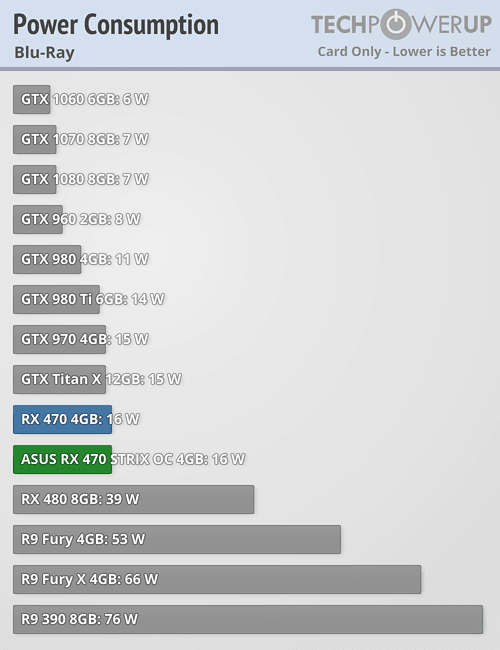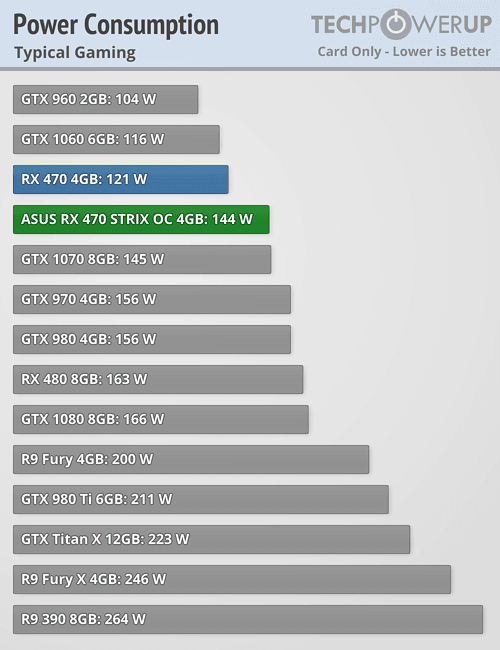 126
126
ASUS Radeon RX 470 STRIX OC 4 GB Review
Fan Noise »Power Consumption
Cooling modern video cards is becoming more and more difficult, especially with users asking for a quiet cooling solution, which is why engineers are now paying much more attention to the power consumption of new graphics card designs. An optimized fan-profile is also one of the few things board vendors can create to impress with reference designs where they are prohibited from making changes to the thermal solution or components on the card.
For this test, we measure the power consumption of only the graphics card via the PCI-Express power connector(s) and PCI-Express bus slot. A Keithley Integra 2700 digital multimeter with 6.5-digit resolution is used for all measurements. Again, these values only reflect the card's power consumption as measured at its DC inputs, not that of the whole system.
We use Metro: Last Light as a standard test for typical 3D gaming usage because it offers the following: very high power draw; high repeatability; is a current game that is supported on all cards; drivers are actively tested and optimized for it; supports all multi-GPU configurations; test runs in a relatively short time and renders a non-static scene with variable complexity.
Our results are based on the following tests:
Non-gaming power consumption of the RX 470 seems to be slightly improved over the RX 480, but not by enough to catch up with NVIDIA's Pascal cards. A very interesting and long overdue improvement is the low power consumption in Blu-ray playback. AMD is now finally running the card at idle clocks, whereas it ran the idle GPU clock, but had the memory run at its full speed in the past, resulting in massive power consumption. Let's hope this doesn't turn out to be a driver bug that gets "fixed" in the next release.For this test, we measure the power consumption of only the graphics card via the PCI-Express power connector(s) and PCI-Express bus slot. A Keithley Integra 2700 digital multimeter with 6.5-digit resolution is used for all measurements. Again, these values only reflect the card's power consumption as measured at its DC inputs, not that of the whole system.
We use Metro: Last Light as a standard test for typical 3D gaming usage because it offers the following: very high power draw; high repeatability; is a current game that is supported on all cards; drivers are actively tested and optimized for it; supports all multi-GPU configurations; test runs in a relatively short time and renders a non-static scene with variable complexity.
Our results are based on the following tests:
- Idle: Windows 10 sitting at the desktop (1920x1080) with all windows closed and drivers installed. The card is left to warm up in idle mode until power draw is stable.
- Multi-monitor: Two monitors are connected to the tested card, and both use different display timings. Windows 10 is sitting at the desktop (1920x1080+1280x1024) with all windows closed and drivers installed. The card is left to warm up in idle mode until power draw is stable. When using two identical monitors with the same timings and resolution, power consumption will be lower. Our test represents the usage model of many productivity users who have one big screen and a small monitor on the side.
- Blu-ray Playback: Power DVD 15 Ultra is used at a resolution of 1920x1080 to play back the Batman: The Dark Knight Blu-ray disc with GPU acceleration turned on. Measurements start around timecode 1:19, which has the highest data rates on the BD with up to 40 Mb/s. Playback keeps running until power draw converges to a stable value.
- Average: Metro: Last Light at 1920x1080 because it is representative of a typical gaming power draw. The average of all readings (12 per second) while the benchmark was rendering (no title/loading screen) is used. In order to heat up the card, the benchmark is run once without measuring power consumption.
- Peak: Metro: We use Last Light at 1920x1080 as it produces power draw typical to gaming. The highest single reading during the test is used.
- Maximum: We use Furmark Stability Test at 1280x1024, 0xAA. This results in a very high no-game power-consumption reading that can typically only be reached with stress-testing applications. We report the highest single reading after a short startup period. Initial bursts during startup are not included as they are too short to be relevant.
Gaming power consumption is considerably reduced over the RX 480, which ensures that the power input configuration doesn't get overloaded. With around 120 W, the AMD reference RX 470 consumes about as much power as NVIDIA's GTX 1060, which, however, is 35% faster in games. Compared to the RX480, the RX 470 is slightly more power efficient.
ASUS has overclocked their RX 470 out of the box, which yields increased performance, but it comes at the cost of efficiency. Compared to the RX 470 reference, efficiency is reduced by about 10%. Power consumption in all our tests is below the 150 W limit of the power input configuration, so all is good here.






Mar 4th, 2025 13:04 EST
change timezone
Latest GPU Drivers
New Forum Posts
- 9070 and 9070XT power consumption leaked by HUB (8)
- Easy to open wired mice (15)
- It's happening again, melting 12v high pwr connectors (1003)
- Windows 11 General Discussion (5782)
- *Severe micro stutters* cyberpunk 2077 Please help (19)
- Will I benefit from changing the thermal pad? (5)
- Have you got pie today? (16619)
- What's your latest tech purchase? (23236)
- Cryptocoin Value and Market Trend Discussion (1615)
- WD Black or Gold for Gaming (10TB) (18)
Popular Reviews
- AMD Radeon RX 9070 Series Technical Deep Dive
- NVIDIA GeForce RTX 5070 Founders Edition Review
- EIZO FlexScan EV4340X Review - A Multitasking Powerhouse
- ASUS GeForce RTX 5070 Ti TUF OC Review
- RAWM ES21M Review
- AMD Ryzen 7 9800X3D Review - The Best Gaming Processor
- be quiet! Pure Base 501 DX Review
- MSI GeForce RTX 5070 Ti Vanguard SOC Review
- MSI GeForce RTX 5070 Ti Ventus 3X OC Review
- ASUS ROG Harpe Ace Mini Review
Controversial News Posts
- NVIDIA GeForce RTX 50 Cards Spotted with Missing ROPs, NVIDIA Confirms the Issue, Multiple Vendors Affected (513)
- AMD Plans Aggressive Price Competition with Radeon RX 9000 Series (277)
- AMD Radeon RX 9070 and 9070 XT Listed On Amazon - One Buyer Snags a Unit (260)
- AMD Mentions Sub-$700 Pricing for Radeon RX 9070 GPU Series, Looks Like NV Minus $50 Again (248)
- NVIDIA Investigates GeForce RTX 50 Series "Blackwell" Black Screen and BSOD Issues (244)
- AMD RDNA 4 and Radeon RX 9070 Series Unveiled: $549 & $599 (234)
- AMD Radeon RX 9070 and 9070 XT Official Performance Metrics Leaked, +42% 4K Performance Over Radeon RX 7900 GRE (195)
- AMD Radeon RX 9070-series Pricing Leaks Courtesy of MicroCenter (158)